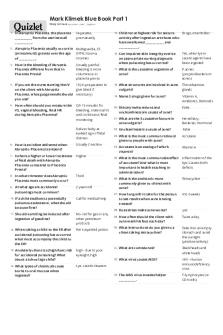The Thin Blue Line Summary PDF

| Title | The Thin Blue Line Summary |
|---|---|
| Course | U.S. Politics Through Documentary Film |
| Institution | Seton Hall University |
| Pages | 2 |
| File Size | 61.4 KB |
| File Type | |
| Total Downloads | 13 |
| Total Views | 174 |
Summary
Official Summary of the film The Thin Blue Line...
Description
The Thin Blue Line Summary The Thin Blue Line is a documentary that tells the story of how a young boy named David Harris framed Randall Adams for shooting a Texas police officer named Robert Wood. However, the film does not simply focus on Harris and how he specifically framed Adams but also how the entire Vidor police department and judicial system participated in the act. We hear that is presumably the “real story” at the very beginning of the film, and it is told from Adam’s perspective. He says that one night he was driving in Dallas, his car ran out of gas, and as he is walking to find a place to fill up his gas can, a young boy asks him if he needs help. This young boy is David Harris. Harris takes Adams to get gas and then follows him to the Motel where Adams and his brother are staying, and the three men hang out, drink, smoke, and go to the movies. At the end of the night, they go back to the motel, and Adams goes inside with his brother without inviting Harris in. Adams makes a sandwich, watches T.V., goes to bed, and wakes up the next morning and goes to work (Morris 00:01). The audience also learns early on that David Harris, who is from Vidor, Texas, stole his neighbor’s car in order to run away from home (Morris 00:02). Therefore, Harris is on the run and does not have anywhere to stay the night he meets Adams. It is unclear if Adams himself knows this information, but we come to find out it is an extremely important detail. Officer Robert Wood is shot the same night that Harris and Adams meet (Morris 00:05). We hear from multiple police officers and detectives that they have absolutely no story or evidence when the crime is initially committed, especially because Wood’s partner was not able to remember the license plate number of the car that the perpetrator was driving (Morris 00:12). However, the officers soon learn of a stolen car from Vidor, Texas, which is sure enough the car that Harris was driving, and they start to connect the dots. However, when they bring Harris in to question him about the crime, he says he didn’t do it, but he knows who did (Morris 00:19). This is the beginning of Harris working together with the Vidor and Dallas law enforcement to create the story that Russell Adams was the perpetrator, though in reality he had nothing to do with it. Adams is brought in after Harris gives the officers his name and he is put in a room and told to sign a confession statement written for him that states Adams shot and killed Officer Wood (Morris 00:06). Obviously, since Adams did no such thing, he adamantly refuses to sign the paper even when he is threatened by the officer with a gun to his head. Later on in the film, we hear testimony from Harris’s friends who openly state that Harris willingly admits to committing the crime the next day and even seems to brag about it (Morris 00:18). Then, the law enforcement involved in the case clearly overlooks or conveniently leaves out many aspects of the crime that should be considered important evidence, like Adam’s signed statement that emphasizes the fact that he does not have any memory of being involved in, and definitely not actually shooting, a police officer that night, which the law enforcement state is a “convenient memory lapse” (Morris 00:28). In addition, when someone claims they find a mark on Harris’s
car that could be where a bullet hit it when Wood’s partner fires at the car when it drives away, the car is towed and demolished before anyone else can examine the mark (Morris 00:32). Edith James and Dennis White then become involved as the defense attorneys for Adams, and they are both completely convinced of his innocence (00:33). What’s the most telling in this part of the film is the history of Vidor, Texas as an extremely racist town and the belief that Officer Wood was Black or of mixed race (Morris 00:38). We learn that Harris committed a robbery of a store at gunpoint right around the time of the murder of Officer Wood, which would not only give him a history of violence but also define his behaviors under the “crime spree theory”, and that his friends actively state that he does not seem to have any remorse about his actions (Morris 00:39). However, the irony is that Adams is the one who gets pinned as the one who doesn’t show any remorse, yet that is because he did not actually commit the crime (Morris 01:05). Essentially, the officers in Vidor, Texas don’t want to convict David Harris because they do “not want to ruin a young man’s life” (Morris 00:40), which is the same rhetoric that has been used over and over again to acquit a white boy or man when, if a Black person or person of color were in that same situation, they almost always get convicted. Eventually, three more extremely questionable witnesses are brought in and, though two of them, Mrs. Miller and her husband, are blatantly labeled as liars with a known dishonest past, they are still believed over Adams himself and all of the evidence that pointed to Harris as the perpetrator (Morris 01:00). Adams is eventually found guilty and sentenced to the death penalty, appeals his case to the Texas Court of appeals which also finds him guilty in a 9-0 vote, but then is ultimately saved from the death penalty by the Supreme Court ruling which overturned the case with an 8-1 vote (Morris 01:13). However, the D.A. of Dallas demanded a retrial for Adams, and he is still serving a life sentence in Texas (Morris 01:37). We hear Harris’s full admittance of framing Adams in an interview at the very end (Morris 01:34), but we also find that everything Adams was convicted based upon (no remorse and trauma from youth) and things that he was lacking (history of violent crime), were actually characteristics of David Harris himself (Morris 01:29). Therefore, The Thin Blue Line highlights the corruption of the Dallas county and overall Texas justice system and the film does seem to confirm the statement made my Adam’s mom which states that, “If there was ever hell on Earth, it’s Dallas County” (Morris: 01:30)....
Similar Free PDFs

The Thin Blue Line Summary
- 2 Pages

Summary - Blue-Collar Brilliance
- 1 Pages

Blue Book PT SUMMARY
- 310 Pages

Summary of Blue Ocean Strategy
- 28 Pages

Práctica \"The Blue Cross\"
- 1 Pages

Blue ocean strategy summary pdf
- 9 Pages

Thin Layer Chromatography Report
- 5 Pages

Lab 10 thin lenses
- 6 Pages

363659998 Thin Cylinder Report
- 19 Pages

Klimek blue part1 - Blue Book Part 1
- 64 Pages
Popular Institutions
- Tinajero National High School - Annex
- Politeknik Caltex Riau
- Yokohama City University
- SGT University
- University of Al-Qadisiyah
- Divine Word College of Vigan
- Techniek College Rotterdam
- Universidade de Santiago
- Universiti Teknologi MARA Cawangan Johor Kampus Pasir Gudang
- Poltekkes Kemenkes Yogyakarta
- Baguio City National High School
- Colegio san marcos
- preparatoria uno
- Centro de Bachillerato Tecnológico Industrial y de Servicios No. 107
- Dalian Maritime University
- Quang Trung Secondary School
- Colegio Tecnológico en Informática
- Corporación Regional de Educación Superior
- Grupo CEDVA
- Dar Al Uloom University
- Centro de Estudios Preuniversitarios de la Universidad Nacional de Ingeniería
- 上智大学
- Aakash International School, Nuna Majara
- San Felipe Neri Catholic School
- Kang Chiao International School - New Taipei City
- Misamis Occidental National High School
- Institución Educativa Escuela Normal Juan Ladrilleros
- Kolehiyo ng Pantukan
- Batanes State College
- Instituto Continental
- Sekolah Menengah Kejuruan Kesehatan Kaltara (Tarakan)
- Colegio de La Inmaculada Concepcion - Cebu





